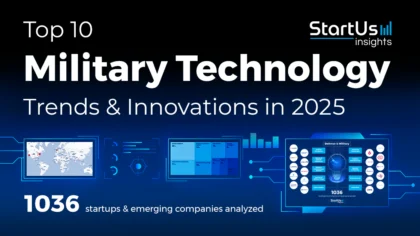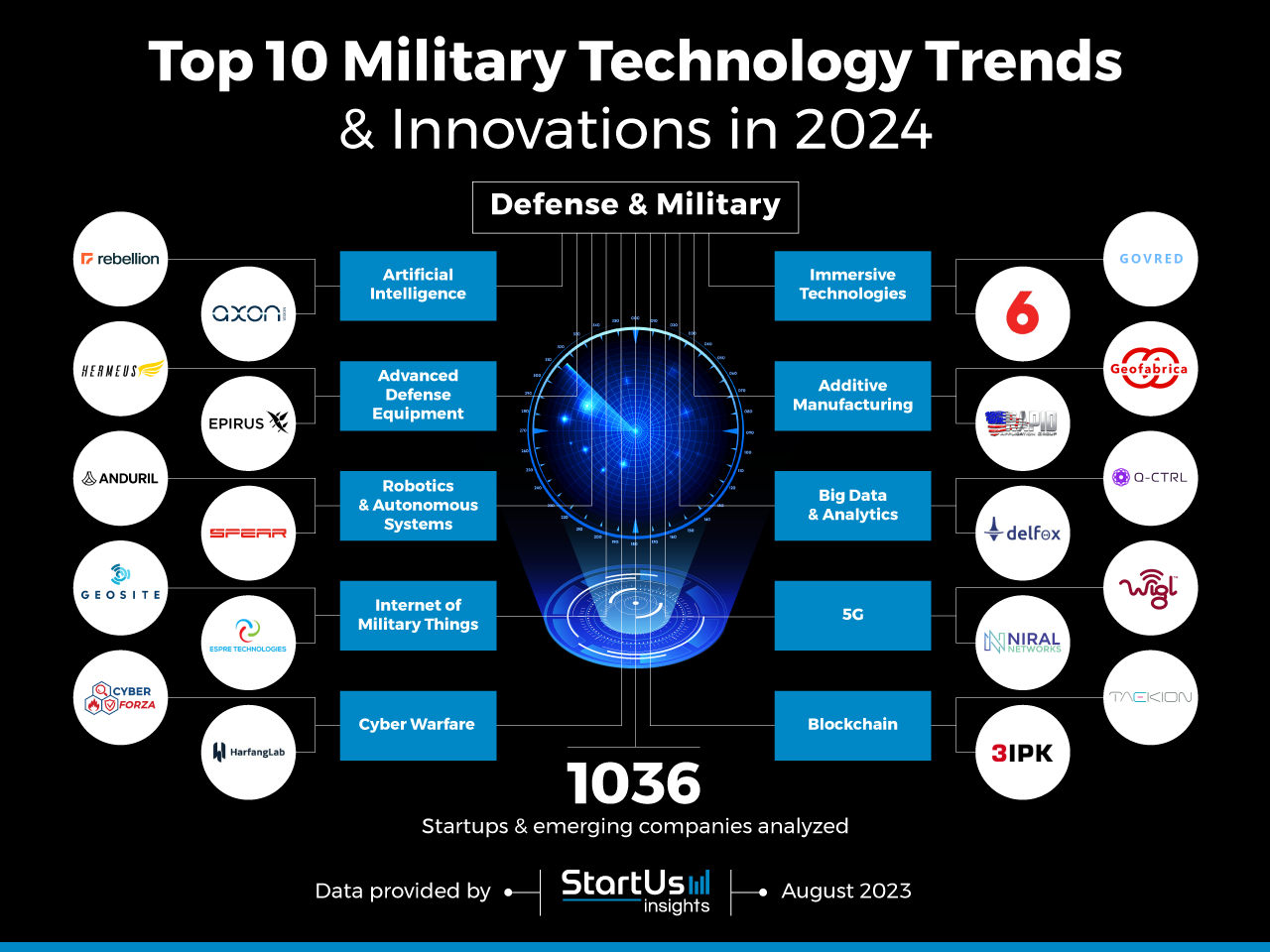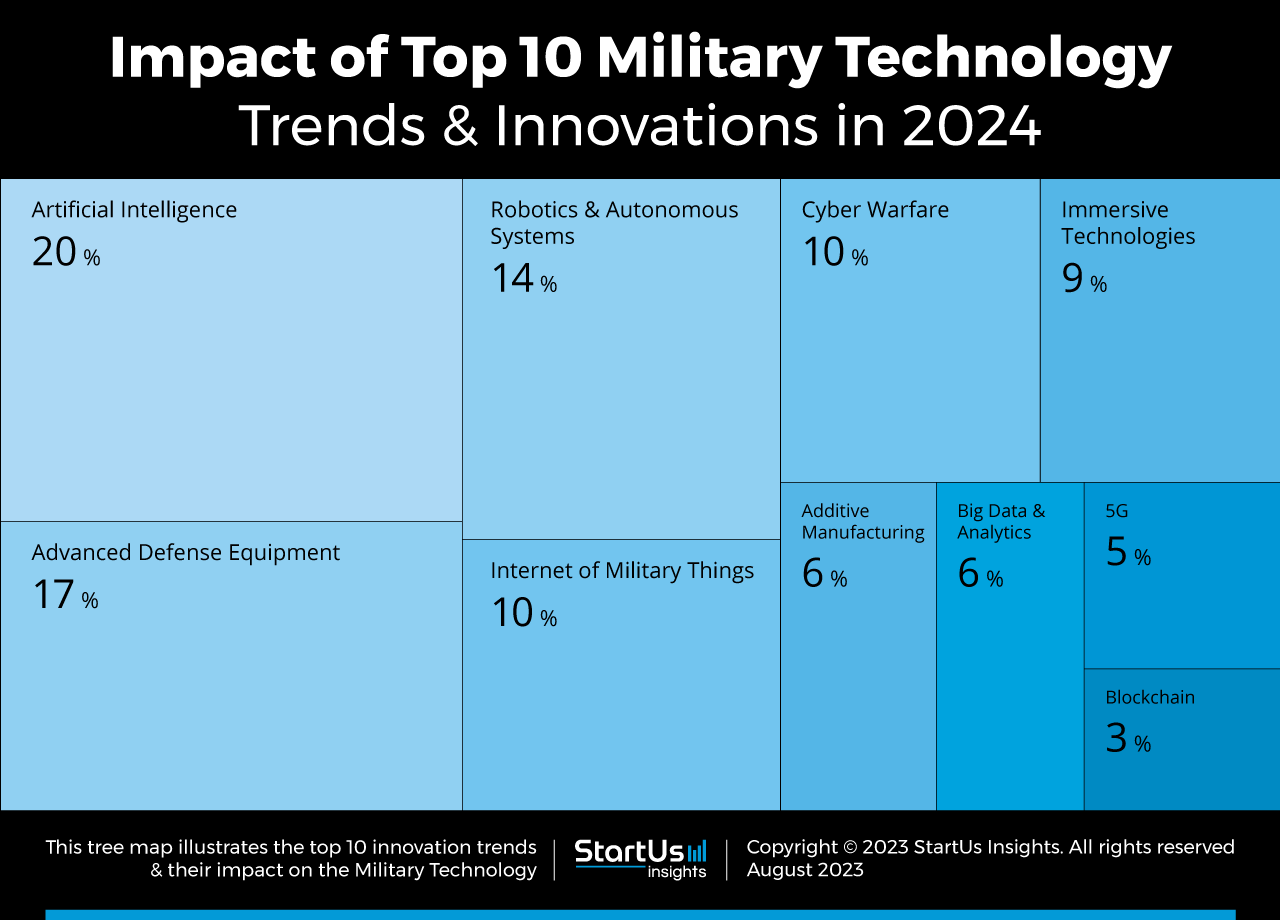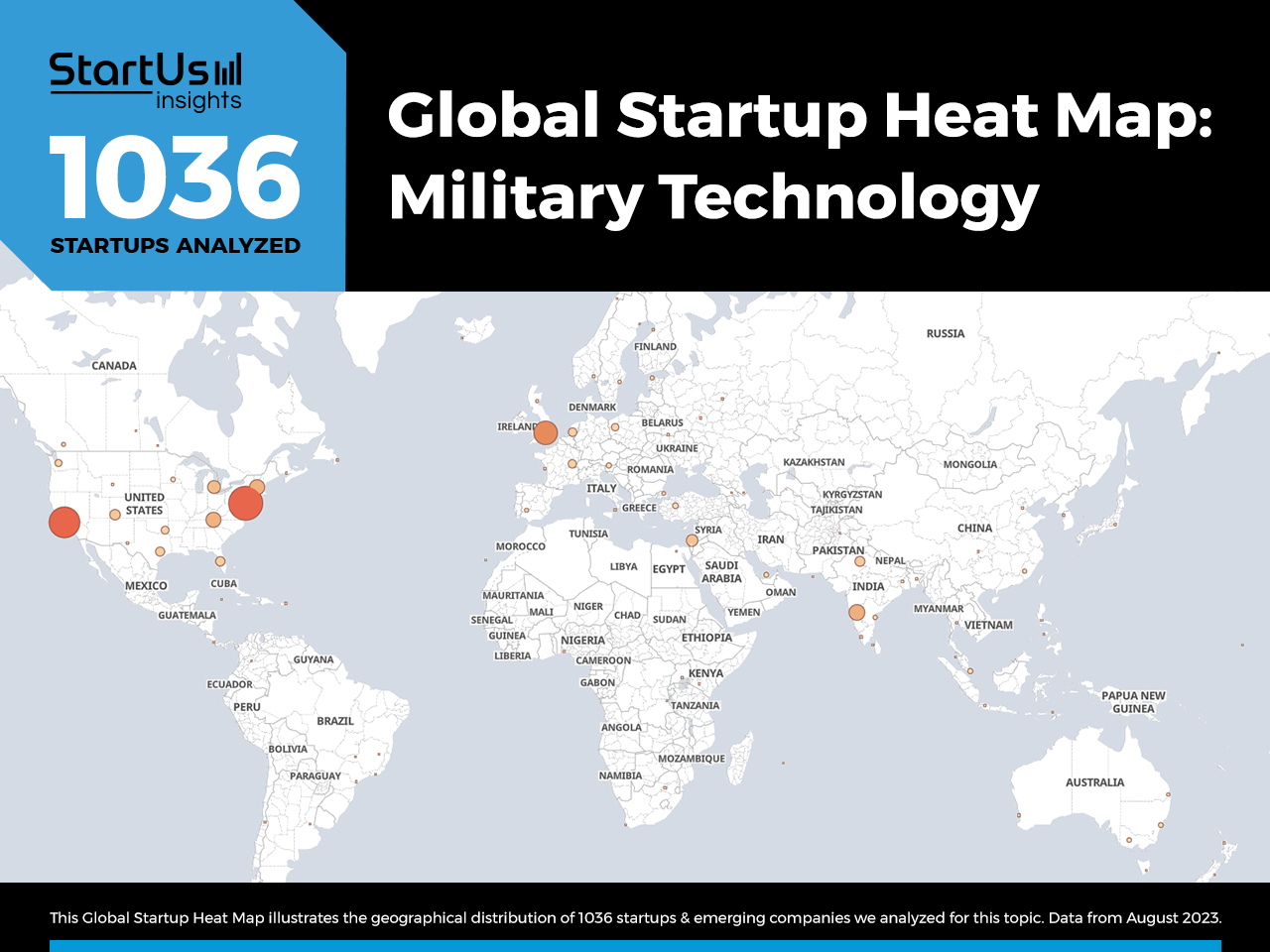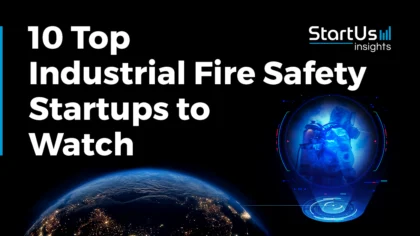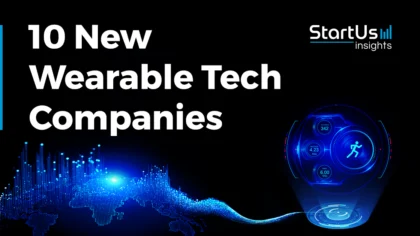The global military landscape is changing due to trends like artificial intelligence, robotics, and the Internet of Things. Hybrid warfare combines conventional and cyber strategies to reshape battlefields in terms of connectivity, lethality, autonomy, and sustainability.
Connectivity improves detection, communication, and coordination, while advanced weapon technologies increase lethality. Robotics and AI allow autonomous decision-making with minimal human involvement. Sustainability advances through additive manufacturing and electrification innovations.
This article was last updated in January 2025.
Innovation Map outlines the 10 Latest Military Technology Trends & 20 Promising Startups
For this in-depth research on the Top Military Tech Trends & Startups, we analyzed a sample of 1036 global startups & scaleups. This data-driven research provides innovation intelligence that helps you improve strategic decision-making by giving you an overview of emerging technologies in the military industry. In the Military Technology Innovation Map, you get a comprehensive overview of the innovation trends & startups that impact your company.
Top 10 Future Military Technologies in 2025
- Artificial Intelligence
- Advanced Defense Equipment
- Robotics & Autonomous Systems
- Internet of Military Things
- Cyber Warfare
- Immersive Technologies
- Additive Manufacturing
- Big Data & Analytics
- 5G Connectivity
- Blockchain
Want to explore all Military Technology innovations & trends?
These insights are derived by working with our Big Data & Artificial Intelligence-powered StartUs Insights Discovery Platform, covering 4.7M+ startups & scaleups globally. As the world’s largest resource for data on emerging companies, the SaaS platform enables you to identify relevant technologies and industry trends quickly & exhaustively.
Treemap reveals the impact of the Top 10 Military Technology Trends
Based on the Military Technology Innovation Map, the Tree Map below illustrates the impact of the top 10 Military Technology Trends. AI is one of the most prominent trends as many nations and companies are increasingly spending more on AI research. The industry is also inventing novel weapons and accessory technologies. Similarly, robotics and autonomous weapon systems improve the combat effectiveness of the military as well as impact other trends in the industry.
Also, there is a substantial rise in the use of the IoT technologies such as sensors, wearables, and edge computing. Cyberspace is another emerging front and startups develop both cyberattack and cyberdefense solutions. Further, immersive technologies find use in military training and combat preparedness. Additive manufacturing boosts the manufacturing capacity for defense components. There are also growing interests in 5G for ultra-high-speed connectivity and blockchain for data security.
Global Startup Heat Map covers 1036 Military Technology Startups & Scaleups
The Global Startup Heat Map below highlights the global distribution of the 1036 exemplary startups & scaleups that we analyzed for this research. Created through the StartUs Insights Discovery Platform, the Heat Map reveals high startup activity in the US, followed by the UK and Israel. Below, you get to meet 20 out of these 1036 promising startups & scaleups as well as the solutions they develop. These military technology startups are hand-picked based on criteria such as founding year, location, funding raised, & more. Depending on your specific needs, your top picks might look entirely different.
10 New Military Technology Trends in 2025
1. Artificial Intelligence
In military and defense, AI adoption enhances computational reasoning for intelligence, surveillance, and reconnaissance missions. This advancement empowers autonomous weapon systems and ensures equipment safety, thereby reducing soldier casualties. Leveraging digital twins and machine learning, defense manufacturers test new iterations of military products. This technology also enables predictive maintenance for military assets, ensuring their longevity and reliability. The global AI in the military market was valued at approximately USD 9.2 billion in 2023 and is projected to grow to USD 38.8 billion by 2028, with a compound annual growth rate (CAGR) of 33.3% during this period.
Startups are at the forefront of developing self-organizing AI systems for military use. These systems utilize swarm computing to work collaboratively towards strategic objectives. Lastly, AI algorithms play a crucial role in analyzing vast amounts of intelligence data. This analysis enhances real-time situational awareness for commanders, providing them with the information they need to make informed decisions.
Axon Vision enables AI-based Situational Awareness
Israeli startup Axon Vision develops an AI-based decision-making engine. The startup’s product, edge360, uses computer vision to provide ground vehicles with complete and automated situational awareness. With an intuitive user interface (UI) and customized alert mechanisms, it detects, classifies, and estimates the whereabouts of threats in real-time.
The startup’s solution allows tactical teams to navigate the threats and obstacles on the field.
Rebellion offers Mission-focused AI Products
US-based startup Rebellion builds mission-focused AI products for the defense and security sectors. The startup uses machine learning and the power of data to deter threats and drive mission success. Its subscription-as-a-service model software products are used for achieving comprehensive battlespace awareness, executing autonomous missions, and cyber readiness.
The software’s user-centric designs are built on open architecture and, hence, are compatible with existing hardware and software systems.
2. Advanced Defense Equipment
In response to emerging threats, more sophisticated defense equipment is being developed. This includes innovations from hypersonic flights and directed energy weapons to space militarization. Aligning with the objective of achieving net-zero emissions, the defense industry is making significant strides. Investments are being made in battlefield electrification techniques, such as electric propulsion and hydrogen fuels for military aircraft. This facilitates a transition towards more sustainable operations.
In addition, research in biotechnology and nanotechnology is advancing, leading to the creation of innovative equipment like self-healing armor. Advanced wearable tech, integrated with biometric sensors, is another area of focus. This technology optimizes combat readiness and situational awareness for soldiers, enhancing their performance on the battlefield. Moreover, the global defense equipment market was valued at USD 517.2 billion in 2023 and is projected to grow to USD 762.1 billion by 2032, registering a CAGR of 4.4% during the forecast period.
Hermeus develops Hypersonic Aircraft
US-based startup Hermeus builds Mach 5 capability aircraft. The startup’s Quarterhouse hypersonic jet is being designed to travel at a speed of 3000+ miles per hour. It uses a proprietary turbine-based combined cycle (TBCC) engine and has both military and commercial applications.
The technology is capable of serving air force missions for intelligence, surveillance, and reconnaissance.
Epirus advances Directed Energy Weapons
US-based startup Epirus develops directed energy weapons systems. It utilizes solid-state, software-defined high-power microwave technology to enable counter-electronics effects for a range of use cases. Featuring an open architecture, the product integrates with existing ground-based, maritime, and airborne systems for multi-layer protection against autonomous threats.
The lightweight pods enable the destruction of critical electronic components, disabling drones.
3. Military Robotics & Autonomous Systems (RAS)
Crucial objectives for militaries include protecting forces, increasing situational awareness, reducing soldiers’ workload, and facilitating movement in challenging terrains. The integration of Robotics & Autonomous Systems (RAS) technologies enables militaries to achieve these objectives, control terrain, secure populations, and consolidate gains. RAS plays an increasingly important role in ensuring freedom of maneuver and mission accomplishment with minimal risk to soldiers.
Drones, a part of this system, enhance battlefield situational awareness. Multi-mission robots and other autonomous military vehicles are instrumental in landmine clearance, search and rescue operations, explosive ordnance disposal, and logistics support. In addition to these, robotic exoskeletons are proving to be a game-changer. They enhance soldier endurance and strength, becoming an essential tool in demanding field operations. Also, the global military robotics and autonomous systems market was valued at USD 9.8 billion in 2023 and is projected to grow at a CAGR of 10% from 2024 to 2032, reaching approximately USD 21.2 billion by 2032.
Anduril develops Unmanned Aerial System (UAS)
US-based startup Anduril offers an autonomous UAS for intelligent air support. The startup’s product, Ghost, is an advanced drone system that uses edge AI algorithms. It is man-portable, waterproof, and has a high payload capacity as well as being able to run a variety of missions in any environment.
Ghost provides real-time surveillance, intelligence, and reconnaissance capabilities, creating a clearer common operating picture to make informed military decisions.
Spear builds Tactical Drones
Israeli startup Spear offers instant action drone-based systems. The startup’s tactical drones utilize computer vision, swarm computing, and mesh algorithms to achieve tactical superiority. The drones are suitable for instant launch from sea or land with both stationary and mobile platforms with a payload capacity of up to one kg.
The drones are easy to operate and, hence, require minimal training and provide a tactical advantage to the ground and special forces.
4. Internet of Military Things (IoMT)
IoT applications in defense connect ships, planes, tanks, drones, soldiers, and operating bases into a cohesive network. This connection enhances perception, field understanding, situational awareness, and response time. Supporting the smooth flow of data across all military branches, edge computing, AI, and 5G strengthen the command and control structure.
Sensing and computing devices, worn by soldiers and embedded in their equipment, collect a variety of biometric data in the IoMT framework. These data points, both static and dynamic, provide valuable insights. Deploying sensor networks in critical areas is another key aspect. This deployment allows for real-time surveillance and environmental monitoring, enhancing security measures. Further, the global IoMT market was valued at approximately USD 400 billion in 2023 and is projected to reach USD 1110.4 billion by 2033, growing at a CAGR of 11.8% from 2024 to 2033.
Espre Technologies enables Network in Network (NIN) Communication
Espre Technologies is a US-based startup that offers a suite of sensor products for NIN communication. The startup’s chipsets enable wireless digital encryption of data along with 10x simultaneous transmissions.
The underlying technology is embedded AI for smart threat detection and smart resource spectrum allocation. The network agnostic, secure & scalable communications are built for the battlefield of things and provide bidirectional communications.
Geosite offers Military Intelligence
US-based startup Geosite aggregates data from different sources for both human and machine analysis. The startup’s collaborative military system uses satellites, IoT, and field sensors to build a common operating picture.
Data visualization, along with management dashboards, offers the advantage of information superiority to plan and execute operations. It aids forces in comprehensive intel for situational awareness, tracking threats, marking ranges, and mapping target areas.
5. Cyber Warfare
Vulnerability to cyber-attacks is a significant concern for military systems, as it could lead to the loss of classified information and damage to systems. The frequency and severity of such attacks have seen a steady increase over the years. Prescriptive security technology, utilizing cybersecurity, AI, and automation, detects potential threats and neutralizes them before they impact defensive cyber warfare capabilities.
Security for connected military equipment, cyber protection for major institutions, and nuclear security are areas of intense focus. Offensive cyber warfare capabilities are also being developed, with techniques ranging from malware and ransomware to phishing attacks. Defensive strategies are being enhanced with the inclusion of advanced firewalls and intrusion detection systems. These systems play a crucial role in protecting sensitive military data and ensuring the integrity and security of military operations. The cyber warfare market size is estimated at USD 92.33 billion in 2025, and is expected to reach USD 221.08 billion by 2030, at a CAGR of 19.08% during the forecast period.
HarfangLab provides Endpoint Detection & Response (EDR)
French startup HarfangLab deploys cyber defense solutions to protect critical infrastructure environments for national defense. The startup’s technology is built on ultra-robust programming, offering both high computing speed and enhanced security.
Its EDR software assists in the supervision, automatic detection, investigation, and neutralization of cyber threats. The open-by-design structure enables the software to easily integrate with existing cybersecurity solutions in any organization.
Cyber Forza offers a Unified Cyber Defense Platform
US-based startup Cyber Forza provides a unified cyber defense platform. The startup’s product has both defender and interceptor capabilities. While the former tackle external threats, the latter addresses internal threats.
The platform also provides AI-based distributed denial of service (DDoS). Moreover, it enables real-time monitoring, phishing fraud defense, and protection from ransomware and malware attacks.
6. Immersive Technologies
The immersive technology in the military & defense market is projected to grow from USD 12.80 billion in 2025 to USD 92.17 billion by 2034. It is expected to have a compound annual growth rate (CAGR) of 24.52% during the forecast period. Building replicable and flexible experiences becomes easier with immersive technologies, especially for flight or combat training. Startups use virtual reality (VR) to construct synthetic training environments (STE). These environments augment traditional training and mission rehearsal, thereby improving the readiness of soldiers and units.
Augmented reality goes beyond virtual reality in military training opportunities. It equips on-field soldiers with wearable glasses or AR headsets, providing mapping information, movement markers, and other data. This technology enhances real-time decision-making for ground forces. In addition to these, immersive technologies assist in mission planning. They provide 3D terrain maps and simulated environments, contributing to a comprehensive understanding of the mission area.
GOVRED enables VR-based Training
US-based startup GOVRED builds VR-based training solutions for the military. The startup utilizes HTC Vive headsets and custom code to create scenarios running at 90 frames per second. This allows users to move around a 25 square meter area, interacting with multiple scenarios.
The startup’s proprietary training technology provides the military with a full line of firearms training and combat simulators.
Red 6 offers AR-based Combat Training
US-based startup Red 6 develops the Airborne Tactical Augmented Reality System (ATARS), a solution for AR-based combat training. The system combines AR and artificial intelligence for air combat military training applications.
It brings virtual and constructive assets into the real world, allowing pilots and ground operators to see synthetic threats in real-time, outdoors, and in high-speed environments. The technology is scalable to multi-domain operations and assists squadrons in enhancing readiness and lethality.
7. Additive Manufacturing
Improving performance in speed, capacity, and fuel consumption is crucial, and reducing the weight of defense equipment plays a significant role in this. 3D printing, a form of additive manufacturing, enables the production of components and parts using less material than traditional methods.
This technology not only reduces production costs but also opens up new design engineering possibilities. It enables localized, on-demand production, thereby reducing the logistical burden. Furthermore, it facilitates the creation of novel material combinations for armor, self-heating military clothing, and ammunition. The global military 3D printing market is projected to reach USD 4.71 billion by 2028, growing at a CAGR of 25.1% during the forecast period (2023-2028).
Geofabrica enables Point-of-Need Manufacturing
Geofabrica is a US-based startup that offers mobile production systems for point-of-need manufacturing. The startup creates solutions for provisional part production, repair, material processing, and assembly on-site in remote or harsh conditions.
The startup’s mobile microfactories and expeditionary 3D printers enable militaries deployed on-site to produce parts on-demand, improving mission outcomes.
Raven Space Systems employs 3D Printing Technology
US-based startup Raven Space Systems develops Microwave Assisted Deposition (MAD) 3D Printing technology for aerospace composite manufacturing. The technology facilitates large-scale 3D printing of thermoset and ceramic matrix composites using standard aerospace-grade resins and fillers. The startup’s MAD 3D printer efficiently extrudes and cures thermally-cured materials.
Its applications span from Mach3D for hypersonic flight testbeds to lightweight aerospace structures and thermal protection systems. The process, offering accelerated production, cost-effectiveness, and adaptability in vehicle size and geometries, is indispensable for the aerospace and defense sectors.
8. Big Data & Analytics
In the evolving landscape of warfare, the role of information and its analysis is becoming increasingly crucial. Harnessing big data analytics, militaries unlock insights from diverse data sources, gaining a strategic edge. Quantum computing, applied in cryptanalysis and simulations, aids informed decision-making.
Efficient interpretation of data from the Internet of Military Things (IoMT) is another benefit of analytics. Predictive analytics, not only deter threats but also enhance the safety and efficiency of perilous tasks. Anticipating potential threats and planning preventive measures is another key application of predictive analytics.
Q-CTRL advances Quantum Computing
Australian startup Q-CTRL offers cloud-based software for maximizing performance in quantum computers. It utilizes quantum computing for various defense applications. The startup’s solution enables cryptographic analysis and sensor-based detection of underground hardened structures and hidden weapons systems.
Moreover, it facilitates quantum-enhanced navigation in GPS-denied battlefields through atomic accelerometers.
Delfox provides Predictive Technology
French startup Delfox provides predictive technology to automate tasks in complex environments, such as for multi-actor cooperation. The technology leverages deep reinforcement learning to learn from data from previously encountered situations and adapts accordingly.
The startup’s products enable maneuvering for unmanned vehicles and the detection and communication of relevant information in a timely manner to the forces.
9. 5G Connectivity
In military operations, the importance of timely and appropriate information is paramount. Accelerating real-time decision support, 5G offers hyper-converged connectivity and secure data networks. This technology paves the way for new command-and-control applications and optimizes logistics. The global 5G in defense market was valued at USD 0.9 billion in 2023 and is projected to reach USD 2.3 billion by 2028, growing at a CAGR of 19.9% during this period.
Furthermore, 5G networks enable the transfer of vast data amounts to remote sensors and weapons, creating dense, resilient battlefield networks. This advancement provides immediate situational awareness and boosts training and battlefield capabilities. Notably, 5G also ensures efficient remote control by offering seamless connectivity for unmanned systems, including drones and autonomous vehicles.
Niral Networks builds Private 5G Infrastructure
Indian startup Niral Networks provides private 5G Infrastructure for last-mile connectivity. Its open and disaggregated network operating system, NiralOS, facilitates 5G and edge computing products. NiralOS integrates with any off-the-shelf white box hardware.
For defense organizations, the 5G infrastructure enables rapid and cost-effective digital transformation on all fronts.
WiGL provides Wireless Electric Charging
WiGL is a US-based startup that offers wireless electric charging via targeted energy through the air. The startup’s patented technology uses a mesh network of wireless transmitters. It converts any wall outlet, vehicle charger, or power source into a smart electric power router.
Communication occurs device-to-device using 5G or Wifi. With wireless charging, IoMT devices are no longer reliant on the availability of batteries.
10. Blockchain
Data security is a crucial aspect of data sharing, and blockchain technology addresses this need effectively. Defense startups are developing solutions based on blockchain to safeguard confidential military data and combat cyber threats. This technology finds use in device tracking, procurement process streamlining, and supply chain security.
In dealing with defense contractors, smart contracts minimize the risk of fraud or corruption. Furthermore, blockchain technology ensures the integrity of internal elections and surveys by facilitating secure voting systems for military personnel.
Taekion enables Military Data Protection
US-based startup Taekion develops technology for military data protection. It leverages blockchain to secure defense data in tamper-proof storage. The UNIX-style distributed file system has built-in compression, encryption, and deduplication features and integrates seamlessly with existing infrastructure.
The technology offers military-grade protection for information security at all levels. Moreover, the digital box feature enables forensic investigations after any cybersecurity attacks.
3IPK provides Blockchain Process Management
Slovakian startup 3IPK offers a process management system for the defense and aerospace industries. It combines blockchain with data analytics and artificial intelligence. The solution automates the supply chain and maintenance processes.
Moreover, it enables smart contracts that increase traceability and transparency, leading to efficient process management and quality control.
Discover all Military Technologies & Startups
It is important to realize that the landscape of war is changing at an exponential pace with new disruptive technologies. Lethal autonomous weapons, intelligent systems, and AI are major drivers for both defensive and offensive military capabilities. Hyper-converged and secured connectivity with 5G and blockchain make military communication safe and robust. From the development of hypersonic jets and directed energy weapons to quantum computing, these trends will have major implications on how militaries operate. This is why defense startups continue to develop military modernization solutions and dual-use technologies that have both military and civilian benefits.
The Military Technology Trends & Startups outlined in this report only scratch the surface of trends that we identified during our in-depth research. Among other technologies, brain-computer interfaces, space militarization, and nanotechnology will transform the sector as we know it today. Identifying new opportunities and emerging technologies to implement into your business early on goes a long way in gaining a competitive advantage. Get in touch to easily and exhaustively scout relevant technologies & startups that matter to you.
